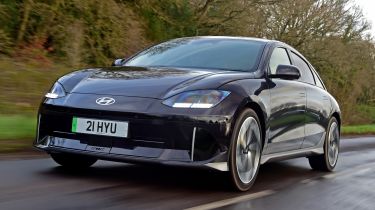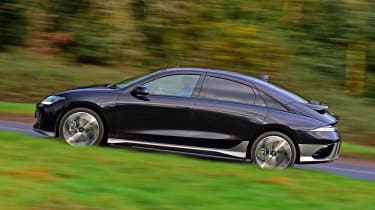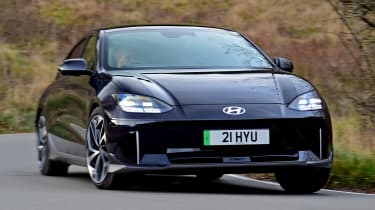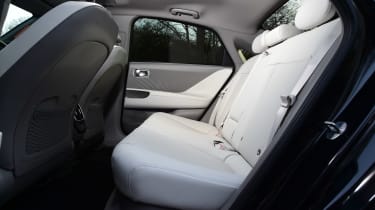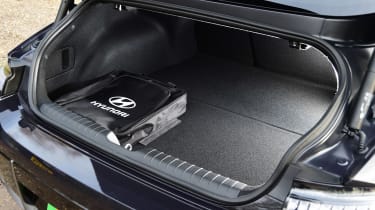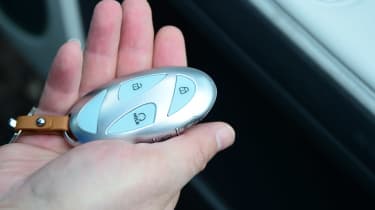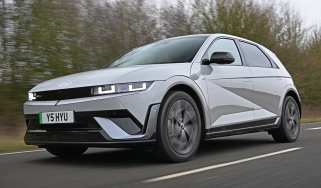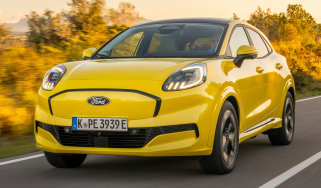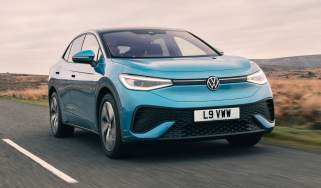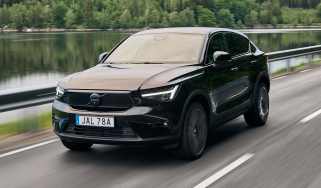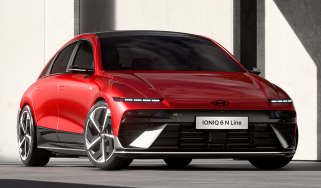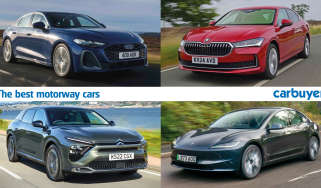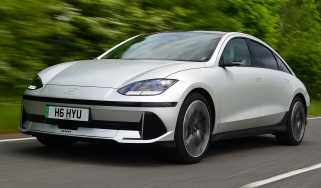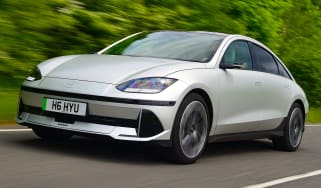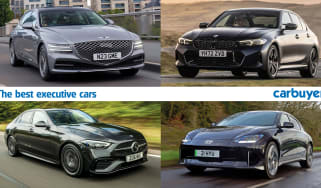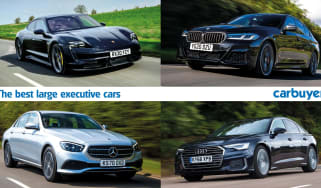Hyundai Ioniq 6 review – a unique EV with limited practicality
"If you value going the distance, the Hyundai Ioniq 6 is devoted to efficiency for a class-leading range"
Pros
- Class-leading range
- Stand-out design
- Good to drive
Cons
- Saloon-style boot lid
- Tight rear headroom
- More expensive than Ioniq 5
Verdict – is the Hyundai Ioniq 6 a good car?
The Hyundai Ioniq 6 is one of the most exciting new EVs hitting showrooms in 2023. Its technology feels like another step on from the already-impressive Ioniq 5, and while the 6’s ‘streamliner’ saloon bodystyle could limit its appeal with buyers who prefer the practicality of an SUV or hatchback, its extra range between charges and engaging drive will make it very desirable amongst EV converts.
Hyundai Ioniq 6 models, specs and alternatives
While the majority of manufacturers have taken a cookie-cutter approach to car design, Hyundai is happy for its all-electric Ioniq models to have unique personalities. The Ioniq 6 may share a lot with the Hyundai Ioniq 5 under the surface, but the two cars look rather different.
Where the Ioniq 5 is retro and blocky, the Ioniq 6 has been designed to be as aerodynamic as possible to maximise its efficiency. While the resulting 0.21Cd drag coefficient might not mean much to you, suffice to say very few cars cut through the air as effortlessly as this Hyundai.
 The 10 best electric cars in 2025
The 10 best electric cars in 2025
We pitted the Ioniq 6 up against five rivals in our electric company-car megatest with the Volkswagen ID.7, BYD Seal, Tesla Model 3, BMW i4, Polestar 2. The Ioniq 6 came in fifth place out of the lineup – though we liked it, the competition is fierce, and the Ioniq 6’s driving experience isn’t quite up to par with the competition. It looks very different to anything else on the road, though, and that might also be enough to sway you if you’re in the market.
The 77.4kWh battery helps it achieve a claimed range of up to 338 miles, beating out the standard Tesla Model 3. That’s with a single motor driving the rear wheels – there’s also a dual-motor version with 321bhp for those who want an extra turn of speed, and who don’t mind sacrificing 16 miles of range. An even-hotter Ioniq 6 N is also on its way later on.
It might seem like a struggle to match the promise of the exterior, but the interior design does a good job. Displays for the rear-facing cameras sit in neat wings on either side of the dashboard, there are two 12-inch screens dominating the real estate behind the steering wheel, and ambient lighting with 64 colours helps lift the atmosphere.
Thanks to its length, the Ioniq 6 is pretty spacious inside too, with plentiful legroom in the front and rear seats. It’s not necessarily the most practical car in the Ioniq lineup, however, with a plunging roofline that limits headroom for tall passengers and reduced footwell space because of the big underfloor battery. It’s also a saloon rather than a hatchback, so like the Tesla Model 3, the boot aperture isn’t very large if you need to load bulky items.
The Hyundai Ioniq 5 has gone down a storm with EV buyers, and the Ioniq 6 blazes its own trail. Instead of taking a slightly retro approach, the Ioniq 6 is radical and futuristic in pursuit of the ultimate range between charges. It’s certainly an exciting model as a result, and rather good to drive, but it’s potentially a bit less family-friendly than the 5, with less headroom and a smaller boot. However, with it recently securing a full five-star Euro NCAP safety score, the Ioniq 6 should still appeal to many tech-loving families and company car buyers.
Range, charging & running costs
Hyundai has taken a lead in electric technology, and that’s no more evident than in the streamlined Ioniq 6. Despite sharing much of its battery and motor hardware with the Ioniq 5, its ultra-aerodynamic shape means range figures are even more impressive.
While there’s an entry-level version of the Ioniq 5 with a 53kWh battery, Hyundai has made no mention of a smaller battery Ioniq 6 coming to the UK. Instead, the electric saloon is fitted with a larger 77.4kWh battery as standard. This means the Ioniq 6 can travel up to 338 miles between charges, beating the 305-mile range of the standard – and slightly cheaper – Tesla Model 3. This is for the Ioniq 6 with a single motor, however – add a front motor and its range figure drops slightly to 322 miles – once again, this is more than the equivalent Ioniq 5, thanks to the 6’s slippery shape. All Ioniq 6s get a heat pump which helps to optimise the battery and mitigate the negative effect of colder weather conditions on the Ioniq 6’s range.
Of course, the story doesn’t end there. The Hyundai’s talent isn’t just its range, but how quickly it can get back on the road again, thanks to its 800-volt electrical system. More volts means more energy can be crammed into the battery cells quickly, so it can be recharged from 10 to 80% in just 18 minutes. In other words, you’d only have time to grab a quick sandwich at the motorway services before being ready for the next stint of your journey.
While you’ll pay a premium for the Ioniq 6 versus an equivalent combustion-engined car, the Hyundai should save its owners money when it comes to running costs. It’ll slot into the lowest Benefit-in-Kind band for company car drivers and cost zero in VED (road tax) until 2025, while also allowing free access to zero emissions zones.
Electric motor, drive & performance
Despite looking so different, the Ioniq 6 is based on the same E-GMP underpinnings we’ve seen in the blocky Ioniq 5 hatchback. Entry-level versions of the 6 will be fitted with a single motor driving the rear wheels, and we’ve driven both this car and the dual-motor model with 321bhp. This is the quickest Ioniq 6 until the high-performance Ioniq 6 N arrives.
The rear-wheel drive Ioniq 6 has 225bhp, which is pretty modest for an EV. However, the controls are all nicely weighted, and the Ioniq 6 still offers strong and smooth acceleration – even if it’s lacking a Tesla-style punch.
Select Sport mode in the dual-motor Ioniq 6 before hitting the accelerator and there’s a near-violent surge of acceleration as it races from 0-62mph in 5.1 seconds – it actually feels quicker than Hyundai’s figures. There’s a massive 605Nm of torque to call upon, and even at motorway speeds, this Hyundai should feel plenty fast enough for almost any driver.
While we first drove an Ioniq 6 set up for South Korean roads, it was easy to tell it was fundamentally good to drive. We’ve now driven it on British roads, which reaffirmed our first impressions that the Ioniq 6 is firmer and more focused than the comfort-oriented Ioniq 5. Despite being fitted with 20-inch alloy wheels, the suspension still manages to round off the worst bumps, however the Ioniq 6 undoubtedly fidgets more than we’d like over rough tarmac. The steering might lack feedback, but it can’t be criticised for its accuracy, weighting, or its ability to take the fatigue out of motorway driving.
In corners, the Ioniq 6 feels secure and planted, so while its weight has an effect on its outright ability, there’s a satisfaction to be had from smoothly stringing a series of bends together. Mounting the big battery in the floor helps, giving the Hyundai a low centre of gravity that helps reduce body lean. The brakes are also a highlight with a consistent feel – but they can be largely ignored if you use Hyundai’s i-Pedal driving mode which increases the braking effect of energy recuperation as you lift off the accelerator.
Our test car had the optional digital side mirrors fitted to it – while these relayed a sharp image to the interior screens at each end of the dashboard, we found the protruding cameras’ prominence meant our eyes were naturally drawn to them instead, which somewhat defeats the purpose – Hyundai could improve this by placing the cameras out of sight, for example underneath the window line. Unless you’re an absolute technophile, though, most drivers will be best served by conventional door mirrors.
Interior & comfort
There are clear parallels with the Ioniq 5 inside, but Hyundai has polished what was already an impressive interior and it now feels somewhat more upmarket, although it’s not as futuristic as the car’s exterior might suggest. Even the plastics look and feel more expensive, and less prone to scratches. The digital door mirror monitors are carefully integrated into wings at either side of the dashboard, and the bezels around both 12-inch displays are now black for a more seamless look – it’s just a shame that the blocky cameras on the exterior look so out of place with the car’s curvy styling. We wouldn’t recommend the digital door mirrors as they’re nothing more than an unnecessary gimmick costing £995.
The Ioniq 6 comes in a choice of two trims: Premium and Ultimate – both of these are well-equipped, so most buyers will be happy enough with Premium. Both get the same 20-inch alloys, adaptive cruise control, matrix LED lights, a rear view monitor, heated seats, heated steering wheel, privacy glass, two-colour ambient lighting and wireless device charging.
Ultimate adds a seat adjustment memory function, leather upholstery, a tilt and slide panoramic sunroof, premium Bose sound system and head-up display. There’s also technology to make parking easier, including a 360-degree camera view and blind spot monitor, while ventilated front seats can help keep you cool in warmer weather.
The infotainment system is a carry-over from the Ioniq 5 consisting of a pair of 12.3-inch screens. It’s quick to respond and mostly very intuitive, with some excellent features like blind-spot displays which appear in the instrument cluster and speed-sensitive ambient lighting with the choice of 64 colours and six themes. The BMW i4’s system is a little sharper but just as quick and both offer wired smartphone integration. Hyundai has also used eco-friendly materials where possible, with recycled plastics and the fibres from fishing nets used in the car’s upholstery.
Boot space, practicality & dimensions
Measuring 4,855mm in length, the Ioniq 6 is 220mm longer than the Ioniq 5, but it’s also narrower and lower. It’s the last of those measurements that have the biggest impact on space because the Ioniq 6’s coupe-like roofline means anyone over six feet may find their head rubbing on the headlining. This isn’t just an issue for those in the rear, either, because even tall drivers may find their head brushing the headliner or positioned in the cutout for the sunroof.
For most back seat passengers, though, it’s the lack of footwell space that will impact comfort. This is caused by the battery pack being mounted under the floor, reducing foot space despite generous legroom.
There are some clever practicality features, including seat backrests that are around 30% thinner than is traditionally the case, freeing up more space. There’s a reasonable amount of storage in the centre console up front. Hyundai also recognises that Ioniq 6 owners are likely to be a tech-savvy bunch, so there are four Type-C USB ports dotted around the interior, plus a Type-A USB for charging and connecting mobile devices.
The boot measures a reasonable 401 litres, but this figure alone isn’t quite the end of the story. As mentioned, the Ioniq 6 is a saloon rather than a hatchback, and the boot aperture isn’t the best shape for loading larger items. The boot itself is also long, wide and shallow, limiting its practicality and meaning pets will need to be transported on the back seat. Rear-wheel drive versions get a practicality boost thanks to a 45-litre ‘wetbox’ storage compartment under the bonnet, which can be used for stowing muddy boots, sports gear or charging cables.
Reliability & safety
The Hyundai Ioniq 6 isn’t quite a big enough seller to feature in the list of the top models in the Driver Power customer satisfaction survey, but as a brand Hyundai came in 17th place out of 32 manufacturers in the 2024 edition of the survey, which is down from 11th place the year before. Customers like Hyundai’s mpg, value for money and safety equipment, but are less keen on the driving feel, cabin quality and finish, and styling.
Reliability is slightly better than average, with around 22% of Hyundai owners reporting an issue with their car within the first year of ownership, and we’re yet to hear of any horror stories regarding the brand’s EV tech in general.
The Ioniq 6 was crash-tested by Euro NCAP in late 2022 under its more stringent testing process and still passed with a full five-star rating. It scored particularly well in the Adult Occupant and Safety Assistance categories, while its autonomous emergency braking was praised when testing against vulnerable road users. One drawback was that the sleek shape of the Ioniq 6 appears to have hampered its pedestrian safety score, although the systems on board did well in limiting the risk of an accident overall.
The Ioniq 6 is also expected to be fully featured when it comes to safety equipment. It ushers in a new generation of Hyundai’s ‘SmartSense’ driving aids, including Highway Driving Assist 2. This can not only keep a set distance from the car ahead, but also steer the car in its lane, adjusting its position if another car gets too close. In countries where the law permits it, the car will also change lanes if the driver taps the indicator stalk. Other safety kit includes autonomous emergency braking, blind-spot collision avoidance and sensors to detect crossing traffic.
Which Is Best?
Cheapest
- Name168kW Premium 77kWh 4dr Auto
- Gearbox typeAuto
- RRP£46,315
Most Economical
- Name239kW Premium 77kWh 4dr AWD Auto
- Gearbox typeAuto
- RRP£50,405
Fastest
- Name239kW Premium 77kWh 4dr AWD Auto
- Gearbox typeAuto
- RRP£50,405
